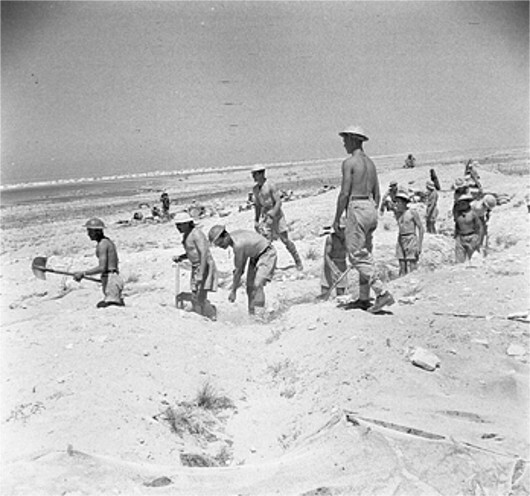Sarah Sundin's Blog, page 127
July 8, 2022
Today in World War II History—July 8, 1942

Patch of the US Tenth Air Force, WWII
80 Years Ago—July 8, 1942: Brig. Gen. Claire Chennault takes command of the China Air Task Force within the US Tenth Air Force, which has absorbed his former AVG (“Flying Tigers”).
US Army Air Force adds rank of Flight Officer for enlisted pilots.
The post Today in World War II History—July 8, 1942 first appeared on Sarah Sundin.July 7, 2022
Today in World War II History—July 7, 1942

US Coast Guard PH-2 seaplane lands to rescue survivors from U-701 – Navy K-type airship overhead had located survivors and dropped raft and supplies. An Army A-29 had sunk U-701 on 7 July 1942 off Wilmington, NC. This rescue took place on 9 July 1942. (US Navy photo)
80 Years Ago—July 7, 1942: US Army Air Force opens Wideawake Field on Ascension Island, opening South Atlantic route for two-engine planes and some fighters (Read more: “Of Terns and Planes”).
In New Guinea, Australian troops begin march north over the Owen Stanley Range from Port Moresby toward Kokoda.
US Army Air Force sinks its first submarine off the US East Coast—an A-29 Hudson sinks U-701 off Wilmington, NC.
The post Today in World War II History—July 7, 1942 first appeared on Sarah Sundin.July 6, 2022
Lakeside Retreat by Marci Seither

All of the restfulness of a lakeside retreat and none of the mosquitos!
There’s nothing like a retreat in nature to refresh you. Getting away from work relieves you of the burden of stress you didn’t realize you carried. Spending time with loved ones reminds you why you love them. Fun activities revive a youthful sense of energy. And best of all, the beauty of God’s creation stirs the heart toward the Creator.
Marci Seither has managed to package all of this into a lovely book, full of gorgeous photography – it even has a ribbon marker! Each short reading in Lakeside Retreat is an escape from work and stress. The recipes and ideas for family activities invite you to connect with family and a childlike sense of wonder. And each devotional story points you to the ultimate source of rest, the Lord.
Marci’s welcoming and engaging writing pulls you in so you smell the pine and feel the lake water on your bare feet. The stories are humorous and touching and inspiring, and Marci extracts incredible stories from the people and scenery around Lake Nebagamon, Wisconsin. Buy one copy of this book for yourself – and another for a friend!

The post Lakeside Retreat by Marci Seither first appeared on Sarah Sundin.
Today in World War II History—July 6, 1942

Anne Frank at school, Amsterdam, the Netherlands, 1940 (public domain via Wikipedia)
80 Years Ago—July 6, 1942: Anne Frank’s family goes into hiding in Amsterdam.
Japanese forces land on Guadalcanal to build an air base.
British First Army is activated; it will participate in Operation Torch, the invasion of North Africa in November 1942.

Map showing Allied and Japanese positions as of 2 July 1942 (US Military Academy)
The post Today in World War II History—July 6, 1942 first appeared on Sarah Sundin.July 5, 2022
Of Terns and Planes

In July 1942, the armies of democracy battled the armies of totalitarianism, but a smaller battle raged between US Army Engineers and a little bird called the sooty tern.
While researching the Army engineers for my novel With Every Letter (Revell, 2012), I ran into an intriguing little story in Barry Fowle’s Builders and Fighters: US Army Engineers in World War II (Fort Belvoir VA: Office of History, US Army Corps of Engineers, 1992).
Airfields Needed
Poster for the US Army Corps of Engineers, WWII
The United States and its “arsenal of democracy” cranked out thousands of fighter planes, bombers, and cargo planes for Allied forces fighting in Britain, North Africa, the Middle East, and the Pacific.
Transporting those planes over the Atlantic and Pacific Oceans was a serious problem as the Germans and Japanese expanded their territories. The trans-Atlantic air routes traversed Newfoundland, Greenland, and Iceland, but these routes were hazardous in winter months. A southern route was greatly desired.
Ascension Island
Map showing the location of Ascension Island (public domain via Wikipedia)
Conveniently located about halfway between South America and Africa, the British territory of Ascension Island offered an alternative. This little 34-square-mile volcanic island has no natural harbor, but does have flat areas ideal for airfields.
Wideawake FieldIn February 1942, the 38th Combat Engineer Battalion of the US Army Corps of Engineers arrived to build Wideawake Field, named for native sooty terns, also called “wideawakes” for their sleep-disturbing calls.
The engineers began building a 6000-foot runway in April 1942. On June 15, two British Fairey Swordfish made an emergency landing on the unfinished airstrip, dodging gunfire until they were identified as Allies.
On July 7, 1942, Wideawake Field officially opened, allowing a better route for single- and two-engine aircraft across the Atlantic. When Brazil declared war on the Axis in August 1942, opening crucial air bases to Allied planes, this route carried large quantities of planes to the front.
The Sooty Tern
Sooty tern (US Fish and Wildlife Service photo)
However, a large rookery of sooty terns lay at the end of the runway. Takeoffs and landings flushed out clouds of birds, and birds and planes don’t mix. Smoke candles and dynamite blasts failed to convince the terns to relocate to other areas of the island. A planeload of cats was brought in. Sadly, as the author writes in Builders and Fighters, “strong-beaked booby birds on the island…found the cats an appetizing treat.”
Following the advice of ornithologist James Chapin of the American Museum of Natural History, the engineers destroyed 40,000 eggs. The terns wisely relocated to a no-fly zone of the island. The engineers, displaying the resourcefulness and ingenuity of their profession, found the tern’s guano made good bricks for constructing base housing.
A Crucial RoleWideawake Field became a vital airfield during World War II. Over 25,000 aircraft stopped at Wideawake while crossing the Atlantic. In addition, aircraft based at Wideawake played an important role in helping drive German U-boats from the South Atlantic.
The post Of Terns and Planes first appeared on Sarah Sundin.Today in World War II History—July 5, 1942

Destroyed Soviet tank near Voronezh, June 1942 (German Federal Archive: Bild 101I-216-0412-07)
80 Years Ago—July 5, 1942: Margot Frank (Anne’s sister) is summoned to a Nazi work camp.
German forces reach the River Don near Voronezh in drive for the Caucasus oil fields.
Gerhard Kunze, the former leader of the German-American Bund (an American Nazi group), is arraigned on espionage charges; he will be sentenced to 15 years.
The post Today in World War II History—July 5, 1942 first appeared on Sarah Sundin.July 4, 2022
Today in World War II History—July 4, 1942

Cover of Ladies’ Home Journal for the “United We Stand” campaign, 4 July 1942
80 Years Ago—July 4, 1942: British First Sea Lord Dudley Pound orders beleaguered Arctic Convoy PQ-17 to scatter; 22 of 33 merchant ships will be sunk en route to Murmansk, Russia, over the next week.
First official US Eighth Air Force operation: 6 US crews join 6 RAF crews flying 12 RAF Bostons to bomb four Dutch airfields, but 3 Bostons are lost (2 US, 1 British).
US AVG (Flying Tigers) is disbanded and absorbed into the new US China Air Task Force; only 5 AVG pilots agree to join the CATF—the AVG had destroyed over 300 aircraft with only 50 P-40s & 9 pilots lost.
Over 100 magazines show US flag on cover for the “United We Stand” campaign.
First American Red Cross Service Club opens in London, the Washington Club.
The post Today in World War II History—July 4, 1942 first appeared on Sarah Sundin.July 3, 2022
Today in World War II History—July 3, 1942

Destroyed harbor of Sevastopol after the battle, July 1942 (German Federal Archives: N 1603 Bild-121)
80 Years Ago—July 3, 1942: On the Crimean Peninsula, Germans take Sevastopol and 100,000 POWs.
RAF flies 780 sorties during the First Battle of El Alamein.
The post Today in World War II History—July 3, 1942 first appeared on Sarah Sundin.July 2, 2022
Today in World War II History—July 2, 1942

US Civilian Conservation Corps poster, 1935
80 Years Ago—July 2, 1942: Churchill’s government overcomes a parliamentary Motion of Censure in an overwhelming vote.
US Depression-era Civilian Conservation Corps is ordered disbanded, completed 30 June 1943.
The post Today in World War II History—July 2, 1942 first appeared on Sarah Sundin.July 1, 2022
Today in World War II History—July 1, 1942

British troops digging defensive trenches near El Alamein, Egypt, 4 Jul 1942 (Imperial War Museum: 4700-32 E 13924)
80 Years Ago—July 1, 1942: First Battle of El Alamein begins—German Field Marshal Erwin Rommel makes deepest penetration yet into Egypt.
Sub USS Sturgeon sinks Japanese transport Montevideo Maru off Luzon in the Philippines; 845 Australian POWS and 208 US & Australian civilians are killed in Australia’s worst maritime disaster.
US discontinues production of alarm clocks to save metal; however, rising absenteeism will lead to a quick repeal (Read more: “Make It Do—Metal Shortages in World War II”).
Destroyer USS Coghlan receives US Navy’s first shipboard twin Bofors 40-mm gun.

Bofors twin-mount 40-mm heavy machine gun aboard the Queen Mary, which was used as a troop transport during WWII, Long Beach, CA, June 2017 (Photo: Sarah Sundin)
The post Today in World War II History—July 1, 1942 first appeared on Sarah Sundin.


